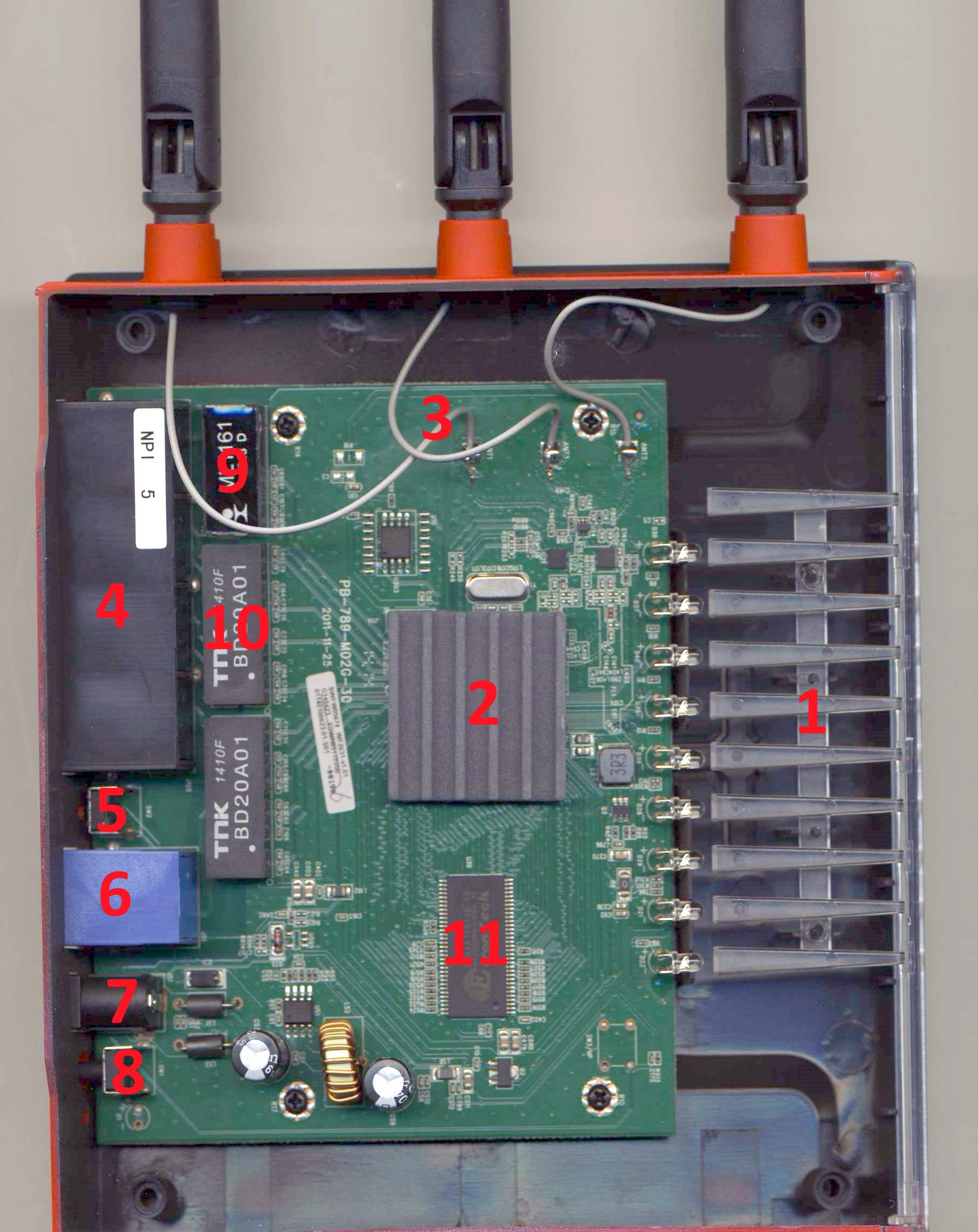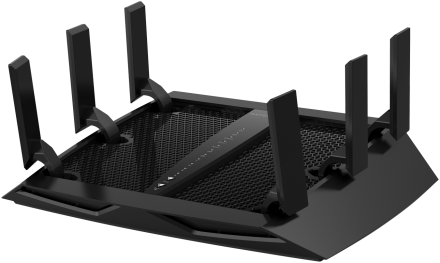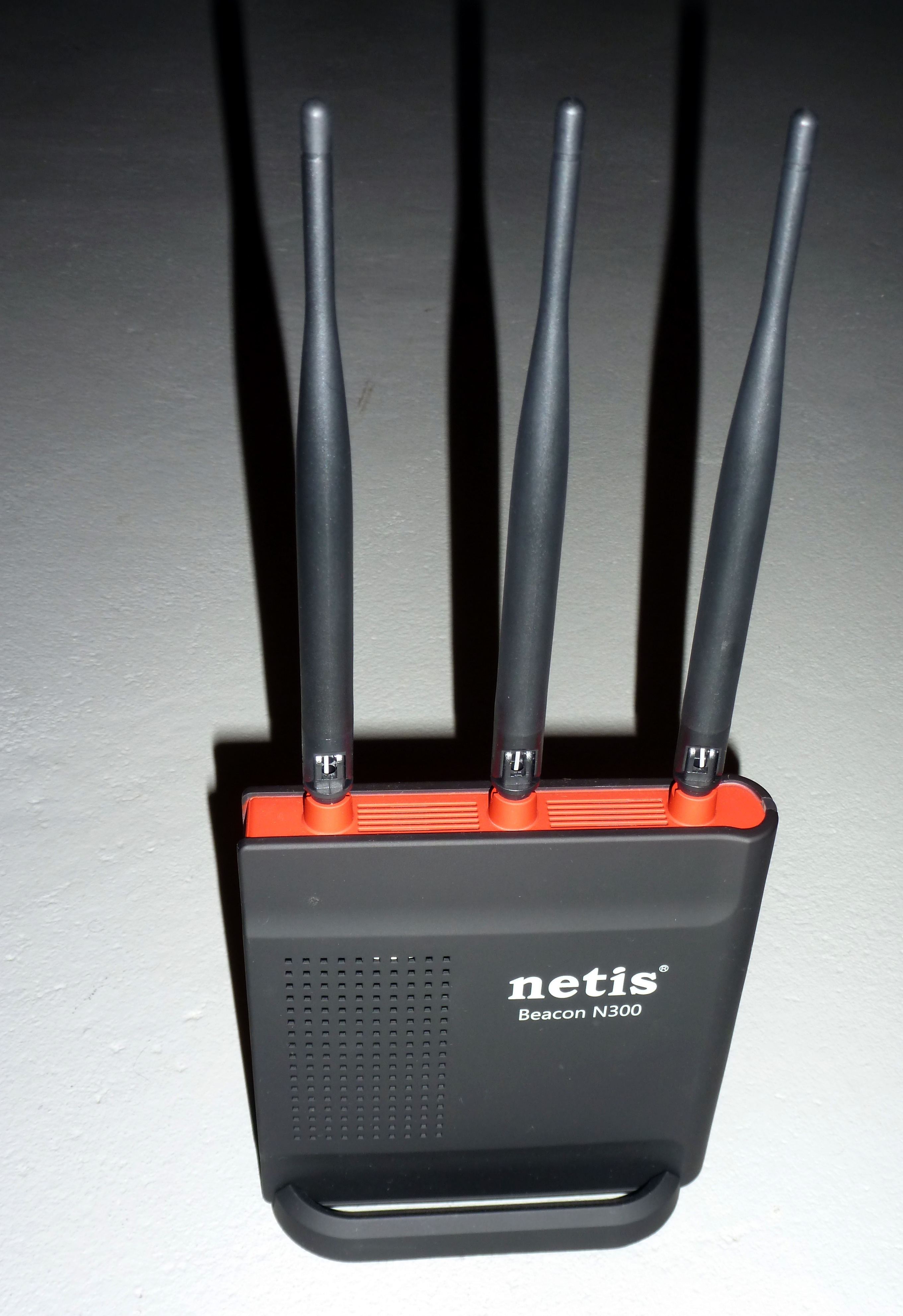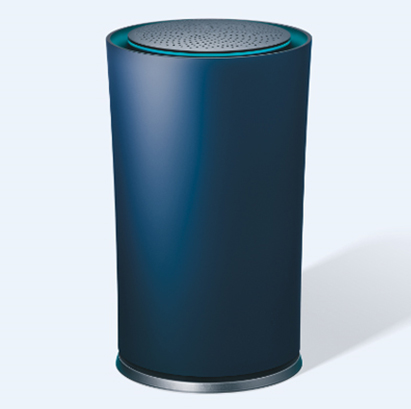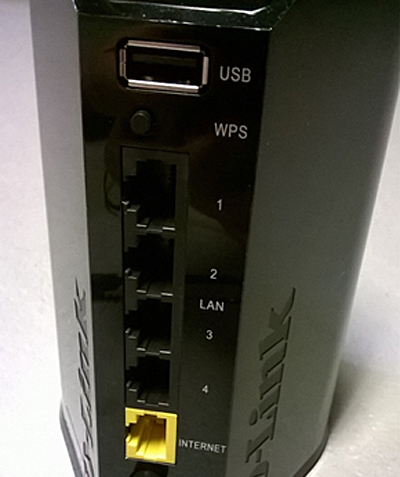Wireless Routers 101
Hardware
System Board Components
Inside a wireless router is a purpose-built system, complete with a processor, memory, power circuitry and a printed circuit board. These are all proprietary components, with closed specifications, and are not upgradeable.
The above image shows the internals of Netis' N300 Gaming Router (WF2631). We see the following components:
- Status LEDs that indicate network/router activity
- Heat sink for the processor—these CPUs don't use much power, and are cooled without a fan
- Antenna leads for the three external antennas to connect to the PCB
- Four Ethernet LAN ports for the home network
- WPS Button
- Ethernet WAN port that connects to a provider's modem
- Power jack
- Factory reset button
- 10/100BASE-TX transformer modules — these support the RJ45 connectors, which are the Ethernet ports.
- 100 Base-T dual-port through-hole magnetics. These are designed for IEEE802.3u (Ethernet ports).
- Memory chip (DRAM)
Antenna Types
As routers send and receive data across the 2.4 and 5GHz bands, they need antennas. There are multiple antenna choices: external versus internal designs, routers with one antenna and others with several. If a single antenna is good, then more must be better, right? And this is the current trend, with flagship routers like the Nighthawk X6 Tri-Band Wi-Fi Router featuring as many as six antennas, which can each be fine-tuned in terms of positioning to optimize performance. A setup like that facilitates three simultaneous network signals: one 2.4GHz and two 5GHz.
While a router with an internal antenna might look sleeker, these designs are built to blend into a living area. The range and throughput of external antennas are typically superior. They also have the advantages of reaching up to a higher position, operating at a greater distance from the router's electronics, reducing interference, and offering some degree of configurability to tune signal transmission. This makes a better argument for function over form.
The more antennas you see on a router, the more transmit and receive radios there are, corresponding to the number of supported spatial streams. For example, a 3x3 router employs three antennas and handles three simultaneous spatial streams. Using current standards, these additional spatial streams account for much of how performance is multiplied. The Netis N300 router, pictured on the left, features three external antennae for better signal strength.
Ethernet Ports
While the wireless aspect of a wireless router gets most of the attention, a majority also enable wired connectivity. A popular configuration is one WAN port for connecting to an externally-facing modem and four LAN ports for attaching local devices.
The LAN ports top out at either 100 Mb/s or 1 Gb/s, also referred to as gigabit Ethernet or GbE. While older hardware can still be found with 10/100 ports, the faster 10/100/1000 ports are preferred to avoid bottlenecking wired transfer speeds over category 5e or 6 cables. If you have the choice between a physical or wireless connection, go the wired route. It's more secure and frees up wireless bandwidth for other devices.
Get Tom's Hardware's best news and in-depth reviews, straight to your inbox.
While four Ethernet ports on consumer-oriented routers is standard, certain manufacturers are changing things up. For example, the TP-Link/Google OnHub router only has one Ethernet port. This could be the start of a trend toward slimmer profiles at the expense of expansion. The OnHub router, pictured on the right, features a profile designed to be displayed, and not hidden in a closet, but this comes at the expense of external antennas, and the router has only a single Ethernet port. Asus' RT-AC88U goes the other direction, incorporating eight Ethernet ports.
USB Ports
Some routers come with one or two USB ports. It is still common to find second-gen ports capable of speeds of up to 480 Mb/s (60 MB/s). Higher-end models implement USB 3.0, though. Though they cost more, the third-gen spec is capable 5 Gb/s (640 MB/s). The D-Link DIR-820L features a rear-mounted USB port. Also seen are the four LAN ports, as well as the Internet connection input (WAN).
One intended use of USB ports is to connect storage. All of them support flash drives; however, some routers output enough current for external enclosures with mechanical disks. If you don't need a ton of capacity, you can use a feature like that to create an integrated NAS appliance. In some models, the storage is only accessible over a home network. In other cases, you can reach it remotely.
The other application of USB on a router is shared printing. Networked printers make it easy to consolidate to just one peripheral. Many new printers do come with Wi-Fi controllers built-in. But for those that don't, it's easy to run a USB cable from the device to your router and share it across the network. Just keep in mind that you might lose certain features if you hook your printer up to a router. For instance, you might not see warnings about low ink levels or paper jams.

Jonas P. DeMuro is a freelance reviewer covering wireless networking hardware.
-
JohnMD1022 "My own personal recommendation would be to look for ... management through a smartphone app."Reply
I do own, nor do I plan to get a smart phone. I have no need for one. There are many others like me. -
dstarr3 Reply"My own personal recommendation would be to look for ... management through a smartphone app."
I do own, nor do I plan to get a smart phone. I have no need for one. There are many others like me.
Do they all post irrelevant comments on tech articles?
-
chalabam Most sites like this one award routers for his raw speed, but when you load them with a simple bittorrent client, they all crash and burn, losing the connections, or being unresponsive.Reply -
Kewlx25 Reply"My own personal recommendation would be to look for ... management through a smartphone app."
I do own, nor do I plan to get a smart phone. I have no need for one. There are many others like me.
Local cellphone companies are dropped non-smartphone support next year. Something about a Federal regulation that states you can't treat data and voice separately, so they're going top do everything over data, which means your phone needs to support VOIP and non-smartphpones can't do that.
Get a smart phone for $60/m or pay $40/month for a land-line. I can also use my phone as a 2-factor device for most of my online services. -
zodiacfml Not a bad article compared to the previous LAN article. I need to clarify some things though. DMZ in home Wi-Fi routers are is not on a separate network but a feature that allows all traffic to be received by the DMZ'ed computer which is an easy and fast way to open a server to the internet.Reply
MIMO piece needs to be overhauled. There is no concept of MIMO built for single user, it is just Wi-Fi is inherently a broadcast type of networking where each device in the system waits for its turn to transmit/broadcast a signal.
Beamforming piece should precede MU-MIMO as beamforming is the technology that enables MU-MIMO. MU-MIMO is useful for reusing the same frequency/channel up to four times as though as one client has it its own dedicated Wi-Fi access point/router. The number of antennas though doesn't tell the maximum, the optimal number MU-MIMO devices is three only on a four antenna MU-MIMO. It has to be added that MU-MIMO feature should also be supported by the client device though flagship smartphones in 2016 will have MU-MIMO. One small drawback is it is limited to download or from router to device only. Uploads will be limited to plain old Wi-Fi broadcast technology.
The device to get though should at least be an "AC" capable Wi-Fi router even if it has one spatial stream or one antenna as they are available and affordable. Two antennas might be beneficial to tablets and some laptops while three benefits a Macbook Pro or wireless bridging to another router.
-
Dsmith_Topgun who the hell is netis and why are we suggesting equipment with known vunerabilities http://blog.trendmicro.com/trendlabs-security-intelligence/netis-routers-leave-wide-open-backdoor/Reply -
reviewerx Personally, I think one of the best security features is the ability to only allow specific MAC addresses to connect. This limits your users to known devices only. Kind of surprised that it is not mentioned here.Reply -
BrushyBill Reply"My own personal recommendation would be to look for ... management through a smartphone app."
I do own, nor do I plan to get a smart phone. I have no need for one. There are many others like me.
Local cellphone companies are dropped non-smartphone support next year. Something about a Federal regulation that states you can't treat data and voice separately, so they're going top do everything over data, which means your phone needs to support VOIP and non-smartphpones can't do that.
Get a smart phone for $60/m or pay $40/month for a land-line. I can also use my phone as a 2-factor device for most of my online services.
Landline for me. We don't get Cell service out here where I live. The beauty and pain from living way out in the wilderness. Extremely relaxing but we lose services like this.
